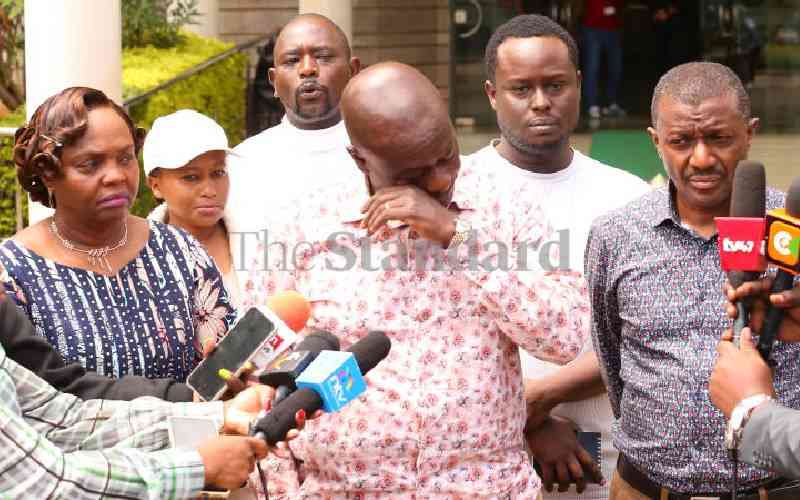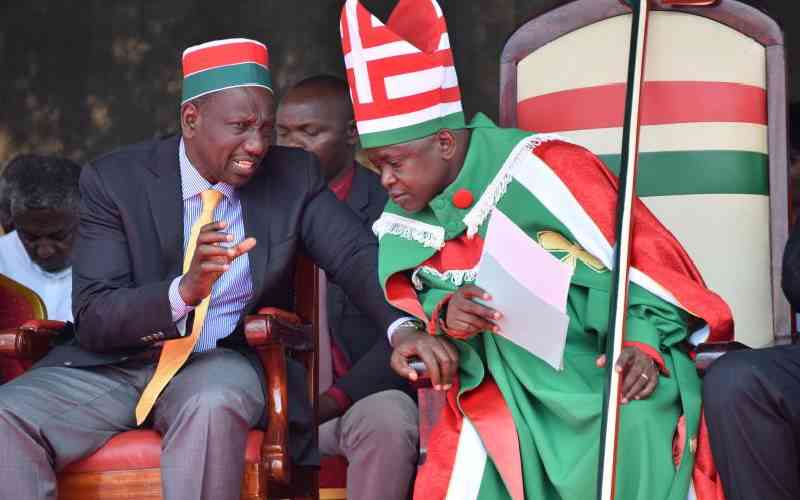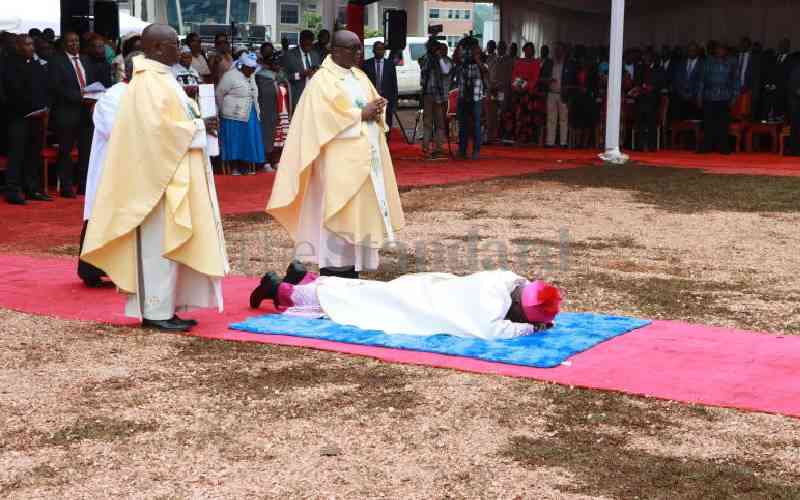
This, however, is not the end of media in Kenya- the history of the country's media has shown that the industry is very resilient, and many times has withstood harsher treatment, to live for another day. Things have changed yes, and therefore different ways of doing business are now required to stabilise it. Inducting into the system a more nuanced and coordinated industry approach to face current challenges will give it stability.
While other countries are working on very innovative viability and sustainability models for their media, for free and responsible as an accountability partner in the democratisation process, players in the sector in Kenya are busy butchering a free press.
There is increased unhealthy competition coupled with declining advertising spending and revenue, increased harassment of journalists, increased operation costs, sectarian approach to policy issues by media owners and absent political goodwill. This has brought about desperation in the media sector.
Majority of media houses in Kenya are private business enterprises. This means that apart from performing their primary roles of media, the enterprises are also keen on attracting revenue and making profit, which is the lifeline. This interferes with the editorial independence of media outlets as they struggle to free themselves from the grip of clients seeking favourable coverage.
The Government still runs the State Broadcaster, the Kenya Broadcasting Corporation, the Kenya News Agency, the Kenya Film Commission, the Government Advertising Agency and the myGov print publication.
Funding and business management have been among the biggest challenges to the sustainability of pluralistic media in the African region. Support for the establishment of media outlets has come predominantly from private entrepreneurs or the state, and in some cases the practice of politicians or their family members owning, buying up or starting up media outlets has not changed significantly in the past six years.
Mainstream financial institutions, such as banks, have not been an important source for financing media in Africa. While the Constitution through Articles 33, 34 and 35 largely provide for freedom of expression and access to information, the country still retains in its statutes many laws and practices that, restrict or threaten survival of independent media and by extension freedom of expression in the country.
Starting with the repeal of the penal code, that provided for sedition during the Inter-Parties Political Group deal in 1997 to the formation of a Task Force on Press Law to inter alia: "make recommendations on Press Law providing for a comprehensive legal framework for the exercise of the freedom of the Press and the development of dynamic and responsible print and electronic media, making provision, inter alia, for free access to information and its dissemination; a code of professional and ethical standards; and ownership, development and licensing of the media," in 1993. The long journey Kenya's media has travelled.
Use of judicial processes was not spared either and suspect judgments were made against the media while in some instances huge defamation penalties were given in favour for individuals close to power then. For instance, in January 1992, The AG moved to the High Court to stop the editors of Society magazine from publishing, distributing or selling an issue of the magazine whose cover had the portrait of the president holding his chin and the words "The Cost of Killing Ouko" and "Kibaki Wants Moi Out."
The case of the broadcasting licences and ensuing wrangles and court battles between Government, NMG, KTN and RMS over the issue of frequencies is a long story. But shortly after, the Government liberalized the airwaves in 1991. In 1994 the AG obtained leave from the Court of Appeal to institute contempt proceedings against a reporter, the editor and publishers of The People for the contempt of scandalising the court. The reporter of The People published a story headlined "Court of Appeal Ruling on Dons' Case Reeked of State Interference" and in which the court ruling was linked to the president's speech.
Henry Muoria in his book "The Gikuyu and the white fury" narrates his interesting brush with the law of sedition. In 1947, Muoria's weekly publication, Mumenyereri, was very popular among the Gikuyu. Muoria received some news from two eyewitnesses who told him that they had been at the Uplands Beacon Factory where they saw two brothers in a crowd being shot dead by armed police. He published the news to the great annoyance of government officials who insisted that it was a false report. He was arraigned in court for publishing false news.
Dickson Otieno, a schoolteacher was imprisoned for 18 months for possessing the following books; Geography of China, Wages, Prices and Profits in Archaeological Finds in China (Daily Nation, 1 August 1978), because the books were published in foreign languages and publishing in foreign languages was banned - in line with Cold War politics. In 1960 Lawrence Oguda, a legislator in Kenya's parliament, lost his seat and was jailed for criticizing the colonial government during a public rally.
In 1980s and 1990s, Kenya's affront to press freedom and freedom of expression using sedition laws, heightened. The harsh application of the laws to bar opposition politicians from selling their ideas to Kenyans had the chilling effect of curtailing press freedom in the country. Actions directed at curtailing political talk ended up shrinking media freedoms, either by design or default.
In 1987, which was proclaimed a ear of Discipline, day-to-day editorial control of content and perspective was exerted by the Office of the President, through direct-censorship - telephone directives or written instructions backed up by threatened or actual arrest and imprisonment of individual journalists. Indirect methods included threatened or actual withdrawal of government advertising.
This period witnessed the banning of the highest number of publications, arrests and sedition charges in the history of the country. In most of the cases, the motive behind charging people with possession of seditious publications appeared to be to punish them for their views or association with opposition politicians.
Stay informed. Subscribe to our newsletter
Other arrests were of people who produced, distributed, sold or had in their possession music cassettes of popular songs criticizing the government. Reverend Lawford Imunde and Sheikh Aziz Said Rimo, were sentenced to six years imprisonment in 1990 for possession of a "seditious publication". Other victims of the system included Charles Rubia, Kenneth Matiba, Raila Odinga, Joe Ager, Christopher Kamuyu, (charged with possessing a prohibited publication, Financial Review) Joe Mwangi Mathai (company recorded and sold political songs), Gerald Chirabika Beti and Elijah Rukose Khasalika (for shouting, "Up with Matiba, and making V signs in Kakamega) and Charles Rukwaro, (sentenced to six months imprisonment for possessing a copy of Financial Review).
Others are George Anyona, Edward Oyugi, Ngotho Kariuki, Frederick Kathangu, Dr. Willy Mutunga, Mary Ager, Florence Nyaguthie Murage, Philip Gachoka Githaiga, a business partner of Kenneth Matiba and his election agent (arrested for being in possessing a leaflet of an underground political organization, Mwakenya, Muuangano wa Wazalendo wa Kukomboa Kenya, Union of Patriots for the Liberation of Kenya) whose leaflets have called for the violent overthrow of the government and Caleb Mokaya, a schoolteacher (possessing a Mwakenya publication).
Many publications continued to endure the most of the government's antics including banning, confiscation of publications, denial of advertisements and the arrest journalists. The culprits included Beyond, Society, Nairobi Law Monthly, Finance, African Confidential and Financial Review. In 1990, Gitobu Imanyara, then the editor of the Nairobi Law Monthly was charged with publication of a seditious magazine. Imanyara's offense was that, in the April/May 1990 edition of the Monthly, he ran an article called "The Historic Debate: Law, Democracy and Multi-Party Politics in Kenya.
Mr Bwire is the Head of Media Development and Strategy at the Media Council of Kenya.
 The Standard Group Plc is a
multi-media organization with investments in media platforms spanning newspaper
print operations, television, radio broadcasting, digital and online services. The
Standard Group is recognized as a leading multi-media house in Kenya with a key
influence in matters of national and international interest.
The Standard Group Plc is a
multi-media organization with investments in media platforms spanning newspaper
print operations, television, radio broadcasting, digital and online services. The
Standard Group is recognized as a leading multi-media house in Kenya with a key
influence in matters of national and international interest.
 The Standard Group Plc is a
multi-media organization with investments in media platforms spanning newspaper
print operations, television, radio broadcasting, digital and online services. The
Standard Group is recognized as a leading multi-media house in Kenya with a key
influence in matters of national and international interest.
The Standard Group Plc is a
multi-media organization with investments in media platforms spanning newspaper
print operations, television, radio broadcasting, digital and online services. The
Standard Group is recognized as a leading multi-media house in Kenya with a key
influence in matters of national and international interest.





